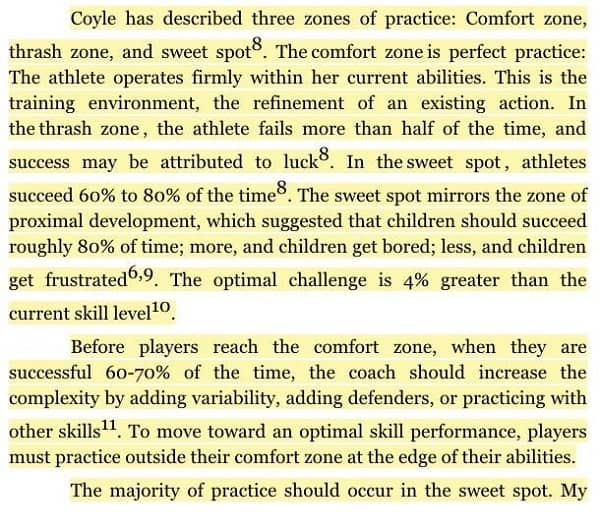One Drill and Different Skill Levels? How to Maximize Improvement By Challenging Every Player On Your Team Effectively
One challenge for coaches at all levels is that your players have a wide range of skills within one team. Some are great at ball handling. Others not so much. Some shoot a high percentage. Others have trouble hitting the rim on every shot.
This can make it difficult to appropriately challenge each player throughout practice and workouts.
The same drill that might be great for your elite ball handler might be detrimental for your weakest ball handler and vice versa.
If you don't challenge them enough, they can get bored. If the task is too difficult, they can lose confidence and get discouraged.
Obviously, you want to challenge each player appropriately, so they can constantly improve. The more time your players spend improving and the more efficient you are, the better your team will become...
Over time, maximizing improvement for each player can create the difference between great teams and mediocre teams!
You want to hit that "sweet spot" of development for each player.
The concept of the sweet spot is discussed in The Talent Code by Daniel Coyle and the 21st Century Basketball Practice by Brian McCormick. Here's an excerpt from McCormick.

So How Do You Challenge Each Player Appropriately Within the Same Practice Segment!?!
It's all about planning, progressions, and grouping.
First, you need to plan your practices, so you have beginner to advanced variations of each drill that you plan to use.
For competitive drills with defenders, here are a few universal ways to adjust the difficulty level...
- Shrink or expand size of court in use
- Move starting spot of initial defender
- Add or reduce defenders
- Use a shot clock
- Use training aids such as arm extenders for defenders
These are just a few ideas. With some creativity, you could come up with other effective ideas.
Here are four progressions for a full court 1v1 ball handling drill.
1 - 1v1 full court using entire width of floor
2 - 1v1 full court using entire width of floor with a 6-second time limit to score
3 - 1v1 full court using half of the width of the floor
4 - 1v1 full court using half of the width of the floor with a 6-second time limit to score
For progressions 5 through 8, you can do the same thing except add a second defender.
5 - 1v2 full court using entire width of floor
6 - 1v2 full court using entire width of floor with a 8-second time limit to score
7 - 1v2 full court using half of the width of the floor
8 - 1v2 full court using half of the width of the floor with a 8-second time limit to score
Second, prior to practice, you would create your groups of players that you want practicing each progression.
You can even send them to different courts and baskets when appropriate.
Group 1 might work on progressions 1 & 2.
Group 2 might work on progressions 4 & 5.
Group 3 might work on progressions 7 & 8.
And as player's improve throughout the season, you can adjust groups.
4 Shooting Drill Progressions to Better Challenge Your Players
Here's another example. This shows how you might progress through a shooting drill. This is from Nate Sanderson's Game-Based Training System for 2-4 Player Drills
1v1 Shooting Drill With Disadvantage - Fill Up & Read
1v1 Live Shooting Drill - Fill Up & Attack
1v2 Shooting Drill with Disadvantage - Fill Up & Attack
1v2 Live Shooting Drill - Fill Up & Attack
Skills Progression Example For a Drill Without Defenders
For drills without defenders, you would do something similar.
You would list out the technical or mental aspect of each drill. Then you provide the one or two things that you want each group to focus on for the day.
Let's take this footwork drill below.
You could adjust the focus or progression with something similar below.
1 - Correct pivot: Just focus on a front pivot and using the correct foot.
2 - Proper footwork: Next, you might focus on reducing the travels by keeping the pivot foot stationary.
3 - Triple threat position: Now, you can focus on a proper triple threat position. You want their hips back in a 1/4 squat, knees bent, and feet hips width apart.
4 - Ramp up speed of pivot: Now, you try to go faster with the pivot to put more pressure on the defense and become a scoring threat more quickly as you catch the ball.
5 - Sprint into pivot: Now you sprint prior to catching the ball.
6 - Adjust distance: You can add distance to the shot.
7 - Variable practice: You can change pivot foot, pivot type, and distance of shot for each repetition.
I hope this approach helps you create better drills, practices, and workouts for your teams.
Let us know if you have any questions or comments! We really enjoy hearing your thoughts and feedback and the conversations that they create.
What do you think? Let us know by leaving your comments, suggestions, and questions...
|
|||


 Facebook (145k Followers)
Facebook (145k Followers) YouTube (152k Subscribers)
YouTube (152k Subscribers) Twitter (33k Followers)
Twitter (33k Followers) Q&A Forum
Q&A Forum Podcasts
Podcasts